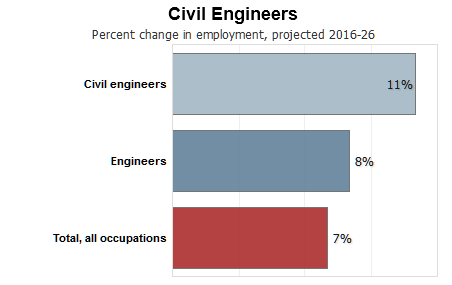
Employment of civil engineers is projected to grow 11 percent from 2016 to 2026, faster than the average for all occupations. As current U.S. infrastructure experiences growing obsolescence, civil engineers will be needed to manage projects to rebuild, repair, and upgrade bridges, roads, levees, dams, airports, buildings, and other structures.
A growing population likely means that new water systems will be required while, at the same time, aging, existing water systems must be maintained to reduce or eliminate leaks. In addition, more waste treatment plants will be needed to help clean the nation’s waterways. Civil engineers will continue to play a key part in all of this work.
The work of civil engineers will be needed for renewable-energy projects. Thus, as these new projects gain approval, civil engineers will be further involved in overseeing the construction of structures such as wind farms and solar arrays.
Although state and local governments continue to face financial challenges and may have difficulty funding all projects, some delayed projects will have to be completed to build and maintain critical infrastructure, as well as to protect the public and the environment.
Job Prospects
Applicants who gain experience by participating in a co-op program while in college will have the best opportunities. In addition, new standards known collectively as the Body of Knowledge are growing in importance within civil engineering, and this development is likely to result in a heightened need for a graduate education. Therefore those who enter the occupation with a graduate degree will likely have better prospects.
Employment projections data for civil engineers, 2016-26
| Occupation | SOC Code | Employment, 2016 | Projected Employment, 2026 | Change, 2016-26 | |||
|---|---|---|---|---|---|---|---|
| Percent | Numeric | ||||||
| Civil Engineers | 17-2051 | 303,500 | 335,700 | 11 | 32,200 | ||



